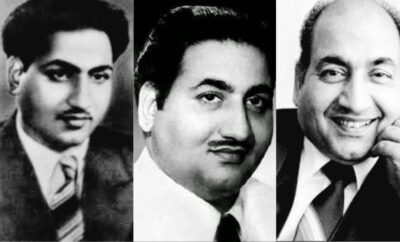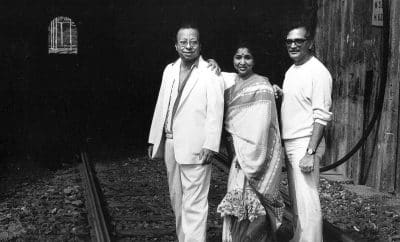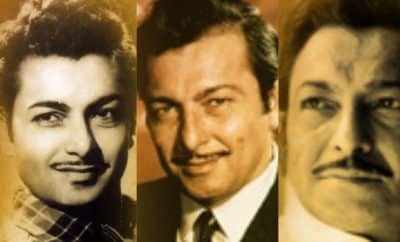Collections
Madan Mohan and the Fabulous Fifties
When one pronounces the two magical words “Madan Mohan”, a music aficionado’s mind is instantly flooded with all the euphonious melodies with which the magician of music has persistently spoilt us for choice throughout his career.
His name is synonymous with finest ghazals that Hindi films have ever had. The name also reminds us of sentimental tunes widely exploring different shades of pathos, that leave an ever-lasting impression in our minds despite sparse and minimalistic orchestration. He unfortunately did not get a due share of success in materialistic terms, for he preferred remaining honest to his art rather than spending the time and energy on ideas to encash it. That is why, whatever music he created was consistently memorable and is cherished by music lovers even today, decades after its creation.
When Madan Mohan’s music is discussed, what is largely talked about is his repertoire in the 1960s and the 1970s. However, a good deal of sweet compositions that he composed during the first decade of his career often remains underrated. It would be interesting to know that the work he did in the 1950s constitutes more than 40% of his total work in terms of number of films. Let us have an express ride through this honeyed but somewhat unsung part of the mellifluous treasure that he has left behind for us.
After having served in army for several years until the end of the second World War, Madan Mohan returned to Mumbai to pursue his interest in music (polar opposite, isn’t it?). He worked for All India Radio for a few years starting 1946 and also recorded a few private ghazals. He started his career in Hindi cinema by assisting composers like S.D. Burman Shyam Sunder and C. Ramchandra. During this period, he also recorded a couple of duets with Lata Mangeshkar under Ghulam Haider’s baton for Shaheed (1948). However, both these songs were eventually dropped from the film. He finally got his first break as a composer in 1950.
Aankhen (1950) was his first film as an independent music director. Already impressed with her singing, Madan Mohan approached Lata Mangeshkar to sing for his first soundtrack. However, Lata Mangeshkar refused the offer, as some of Madan Mohan’s ill-wishers had calumniously poisoned her against him. However, his very first film marked the beginning of his long-lasting collaboration with his favourite male singer Mohammed Rafi. Madan Mohan succeeded in making a mark as a talented music director with Aankhen.
The year 1951 saw only 2 films with the soundtrack composed by Madan Mohan – Adaa and Madhosh. This year however Lata Mangeshkar couldn’t refuse Madan Mohan’s offer to sing for his second film (both the films are mentioned as the historic film by different accounts), and the beginning of a musical era was marked. Whichever was their first film together, the year proved to be lucky for generations of music lovers to come.
Lata Mangeshkar dominates both these soundtracks with saccharine songs like “Saanwri soorat man bhayi re piya” and “Preetam meri duniya mein do din to rahe hote” (both from Adaa); and “Meri aankhon ki neend le gaya” and “Nazron ke chaar hote der nahin lagti” (both from Madhosh). Madhosh also has the famous and soulful Talat Mahmood solo “Meri yaad mein tum na aansoo bahaana”.
The number of Madan Mohan’s films doubled in 1952. The Raj Kapoor and Nargis starrer Ashiana has beautiful Lata solos like “Mere piya se koi ja ke keh de” and “Tum chaand ke saath chale aao”, an awesome Talat solo “Main pagal, mera manwa pagal” and a haunting tandem song “Mera qarar le ja” sung by Talat and Lata separately. Lata Mangeshkar is seen totally missing in Anjaam, which has a beautiful classical composition “Sanwar ke rang rati” sung by chorus”. As Suraiya was the protagonist in Khoobsurat alongside Nasir Khan, she dominates the soundtrack followed by Talat Mahmood. Lata predominantly features in the soundtrack of Nirmohi, the classical song “Dukhiyare naina dhoondhe piya ko” being the most remarkable of all.
Madan Mohan worked on 3 films in the following year (1953). While most of the songs from Baaghi are sung by Lata Mangeshkar (remember the soulful Lata solo “Bahaaren humko dhoondhengi, na jaane hum kahaan honge”?), Asha Bhosle prevails over the soundtrack of the other film Chacha Choudhary. The latter film also has a fantastic classical composition “Aye ri maa ri kaun bahaane” astoundingly rendered by the renowned classical vocalist Dr. Vasantrao Deshpande. The third film Dhoon has two noteworthy Lata solos – “Sitaron se poochho, nazaron se poochho” and “Badi barbadiyaan lekar meri duniya mein pyar aaya”.
Madan Mohan got only 2 films each in the years 1954 and 1955. Whereas most of the songs from Ilzaam (1954) are sung by Asha Bhosle and Kishore Kumar, Asha Bhosle remains the dominant singer with Mohammed Rafi in Mastana (1954). Ilzaam has a philosophical and touching bhajan by Manna Dey – “Ye jag rain basera bande”. Asha Bhosle continues as the main singing entity in Ehsaan (1955), with only a couple of solos sung by Lata Mangeshkar. Madan Mohan’s another film in 1955 was Sunil Dutt’s debut Railway Platform. This film has a somewhat rare combination of Madan Mohan and Sahir Ludhianvi. Lata Mangeshkar, Asha Bhosle and Mohammed Rafi, all feature equally in this soundtrack, together with other singers like S.D. Batish and Manmohan Krishna. The striking songs from this film are the mesmerising Lata solo “Chaand maddham hai, aasmaan chup hai” and “Dekh tere bhagwan ki haalat kya ho gayi insaan” sung by Mohammed Rafi, S.D. Batish and Manmohan Krishna – a parody of sorts based on the famous song “Dekh tere sansar ki haalat kya ho gayi bhagwan” written by Kavi Pradeep and composed by C. Ramchandra for Nastik (1954).
There was a surge in the number of Madan Mohan’s films in the next four years. Amongst his songs from the films released in 1956, the remarkable ones are the frolicky Geeta Dutt solo “Aye dil mujhe bata de”, the historic thumri “Kadar jaane na” by Lata Mangeshkar, and “Mera naam Abdul Rehman” (Kishore Kumar – Lata Mangeshkar), all from Bhai Bhai; “Chal diya dil mera tod ke” (Lata Mangeshkar) from Fifty Fifty; the tandem song “Dil dil se mila kar dekho” with a Kishore and an Asha version from Mem Sahib; and the honeyed Lata and Talat duet “Ye nayi nayi preet hai” alongside several mellifluous Lata solos from Pocket Maar.
Madan Mohan composed soundtrack for around 6 films released in 1957. This year was marked by his unforgettable work Dekh Kabira Roya. Besides, Gateway of India has two sugar dipped songs “Do ghadi wo jo paas aa baithe” (Lata – Rafi) and “Sapne mein sajan se do baaten” (Lata). Chhote Babu also has a pleasant Talat – Lata duet – “Ter chamakti aankhon ke aage ye sitaaren kuchh bhi nahin”. This song has a rare combination of Madan Mohan and the lyricist Indeevar. Other impressive songs from this year include “Chain nahin aaye, kahaan dil jaaye” (Samundar, Lata Mangeshkar) and “Nainon mein pyar dole” (Sheroo, Lata Mangeshkar).
The year 1958 was one of the most successful years (in terms of number of films) in Madan Mohan’s career. He composed the soundtrack of about 8 films released during this year. Among his most discussed compositions from this year are the Rafi solo “Tujhe kya sunaoon main dilruba” from Aakhri Dao, the entire soundtrack of Adalat and an eternal Lata classic “Hum pyar mein jalne waalon ko” from Jailor. The aforesaid Rafi solo from Aakhri Dao is still discussed due to its resemblance with the famous Talat song “Ye hawa, ye raat, ye chaandni” composed by Sajjad Hussain for Sangdil (1952). When confronted by an angry Sajjad on plagiarism, Madan Mohan tactfully replied, “I could not find any better music director to copy.” This rendered Sajjad speechless. One more song from this film has an interesting connect with a song composed by another composer. Listen to the romantic Lata Mangeshkar – Manna Dey duet “Wo chaand muskaya” – does the refrain not remind you of any song that was released a few years later?
Other noteworthy songs from this year are the peppy Rafi solo “Bada hi CID hai” from Chandan, and the classical based Lata solo “Bundaniya barsan laagi re” form Jailor.
The year 1959 also seems to have been good for Madan Mohan, as he composed music for 7 films in this year. In this year, Madan Mohan came up with some fabulous composition like “Saba se ye keh do” (Asha) from Bank Manager; the beautiful classical song “Preetam daras dikhao” (Lata and Manna Dey) and the lovely song “Bairan neend na aaye” (Lata), both from Chacha Zindabad; “Tum chal rahe ho, hum chale rahen hain” (Lata and Mukesh) and the melancholic song “Sajna lagan teri sone na de” (Lata), both from Duniya Na Maane; “Maane na balam pardesiya” (Lata) from Jaagir; the pathos-laden song “Un aankhon mein neend kahaan” (Lata) from Minister; and “Tum ho sath raat bhi haseen hai” (Lata) from Mohar.
The first decade of the era called “Madan Mohan” was thus full of classical and light, romantic and poignant, peppy and soulful compositions, all of which had melody as the essential ingredient. This was the first step towards the qualitatively deeper and broader (albeit quantitively smaller) repertoire that this wizard musician built in the next two decades.




SANJAY PANDYA
June 26, 2021 at 12:37 am
You rightly deserve Hearty Congratulations for the Enriching and ThreadBare Analysis..of A Great Music Legend MadanMohan’s immortal contribution in Hindi Music.!!
Yogesh
June 26, 2021 at 8:59 pm
Thanks, Sanjay ji!
Subramaniam Vaikuntam
June 26, 2021 at 1:44 am
Excellent stuff. Gives me inputs to create my Madan Mohan 1950s playlist. Great work.
Yogesh
June 26, 2021 at 9:00 pm
Thanks SV ji.. I am glad that the writeup was helpful..